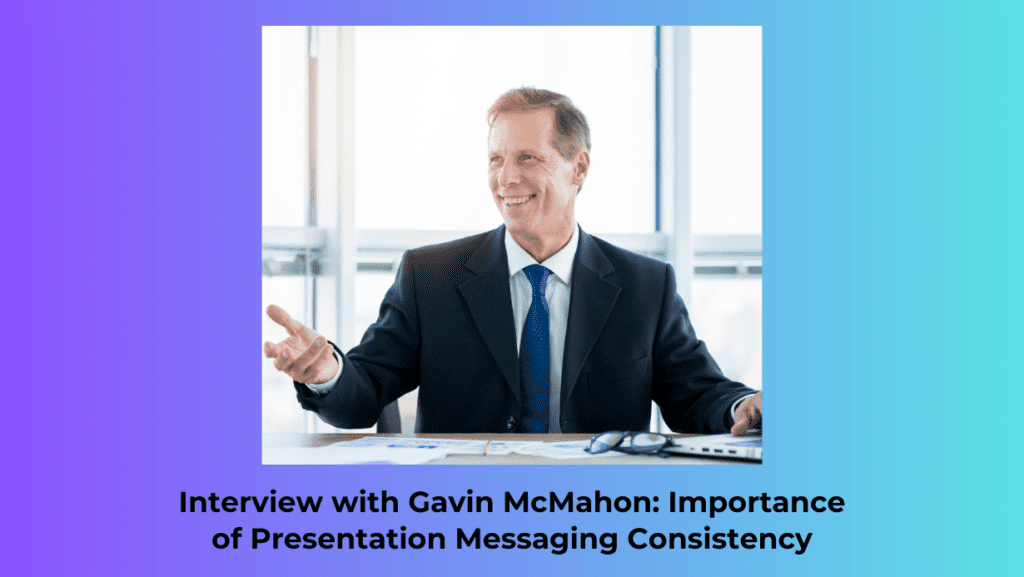We had the pleasure of chatting with presentation expert Gavin McMahon surrounding his insights on presentations as it relates to sales and marketing messaging. Gavin McMahon is a senior partner and co-founder of fassforward Consulting Group. Over the past several years Gavin has advised Fortune 100/500 companies on the impact of market changes and their interrelationship with marketing and business strategy. He brings a unique perspective on growth and innovation, as well as an understanding of the barriers to achieving desired results in these areas. Here’s the second part of our two part interview with Gavin.
What do you think is the key to a great presenter?
First off, they are really, really good at message discipline. Message discipline is thinking what you’re going to say, crafting that story around what you’re going to say, and making it simple enough that it gets through. Using the right words, using the right pictures, using the right structure, and just saying it over and over again – all these are elements that go into a great presentation.
I think that message discipline ultimately is what moves people; it’s what wins elections, it’s what gets people through. I think presentation software such as PowerPoint or CustomShow, which seems like a really small thing in this larger context, is the primary vehicle that businesses use. The presentation is the primary vehicle to carry out that message discipline, to keep repeating that messaging over and over again. And I think most people don’t realize that if you actually want to move a large organization or even if you are a small startup and you want to move markets, message consistency is key.
How do you recommend that companies go about getting that messaging across?
It’s important that the messaging is consistent, simple and emotional. I think it’s making sure that what you do and what you say are really lined up, because when what you do and what you say don’t line up, there’s nothing that kills the brand quicker.
This messaging isn’t just marketing’s problem though. Company leaders need to realize that message discipline is their problem and that’s the way to move a workforce. Additionally, the workforce or whoever you have on the frontline attracting your customers, they have to live up to that brand promise. It’s important that the company is good at crafting the messages, sticking to them, and using that to shape what they present to the market.
From your experience, specific to presentations or not, how do you distill this message down to the sales people and the people who are actually on the front line delivering the message?
People are much more interested if the messaging is talking about you, or at least something relevant to you. If you’re putting something in the hands of the field sales force, you’ve got to construct something that allows them to talk about the client that’s in front of them, in a very non-clunky way. The goal is to do it in a way that gives them a framework to something that can help the hero. The hero of the story is the client or the prospect.
In terms of message discipline, how do you work with clients to balance between staying disciplined, staying consistent, but also making the story about the client? How do you balance consistency and flexibility?
We think about any message or any presentation as having three fundamental elements: “words, structure, and pictures”. If you look at any discipline that’s around creating content they have different words for “words, structure, and pictures” such as a screenplay, cinematography, the plot, but they all deal with these fundamental elements.
What we’ve found is that every individual has a different relationship with words, structures, and pictures; some are much more pictures focused, some are much more structure focused, some are much more words focused. One of our presenter types is what we call a storyteller. They’re the people that are not word focused- people that typically rise very high up in organizations that make very good sales people; they’re the ones that are very comfortable on their feet because they can do five minutes on anything and they sound very plausible and they’re very engaging. They paint pictures with words. So in terms of words, structure, pictures, storytellers have words. These make for interesting speeches but not the best for getting the main message across because it can be very unstructured. In the moment this person will have people eating out of the palm of his hand, but people couldn’t remember what he was saying from minute to minute.
This is a long way around of saying, everyone has these different relationships with word, structure, pictures. If you can build a deck, build a medium, build a framework for an argument that has word, structure, pictures in it, you can then let people loose on that argument. Then they can make it their own presentation and not follow a script but they’re following the points of the main messaging which helps ensure that it will actually come across.
Is there anything else from a presentation point of view that jumps out at meetings that people do or do not do?
I think a lot of people don’t really think about why they’re putting the presentation together. It’s imperative that they know the purpose and they stay true to that purpose. I wish people would think about that more when they put pen to paper.
I think at the end of the day, you’re only really ever trying to do two things: you’re trying to change the way people see the world and get them to do something. When you see a presentation, it doesn’t matter how well packaged it is or how interesting the stories are or the speaker is -if there’s no focus to it, it wastes everyone’s time. There’s enough stuff out there I don’t need more. Have some purpose before you add to the noise, try to think about what your purpose is; if people would do that the world would be much better for it.
Does that tie back to what you were saying earlier about the notion of message discipline? Have something specific to say and stick with it?
Yeah, I don’t think that anyone has a conversation for no reason. Especially in a business contact setting, when you’re having a conversation, have a reason. Be clear about what that reason is. I think a lot of people have sales calls because they have to check off a box and say ‘I wanted to do this.’ You may have multiple reasons, one of them obviously is filling your quota and making your targets, but are you really trying to get that service component to help the person in front of you, or are just trying to sell them something? I think getting clear on the reason would help a lot of people and save a lot of time.
Check out part one of the interview on presentation tools here.


